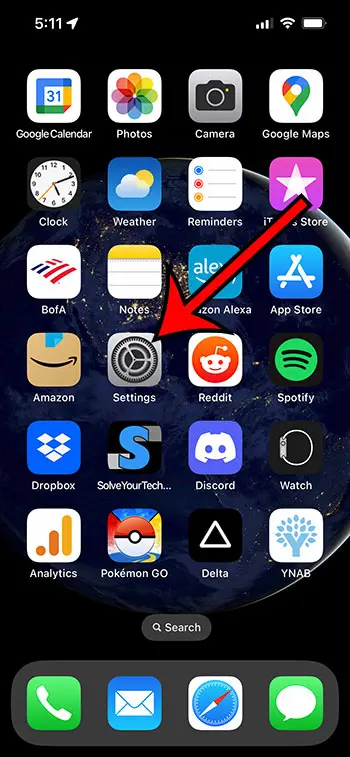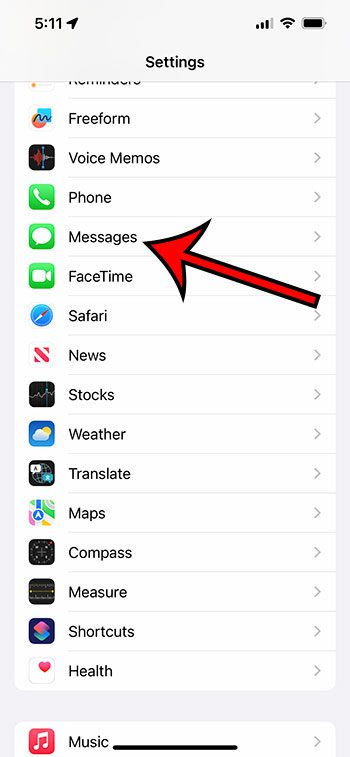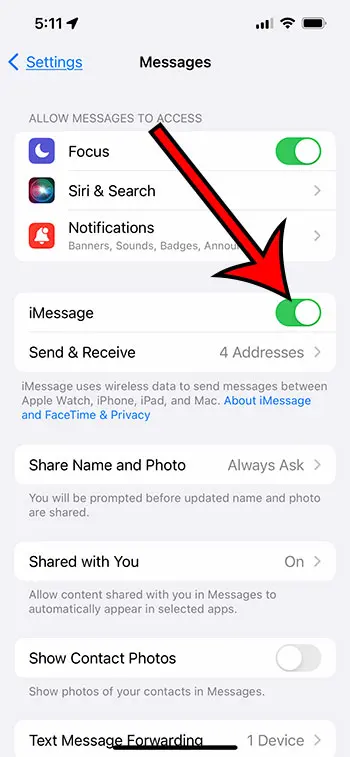Enabling iMessage on an iPhone: A Step-by-Step Guide
- Open your iPhone’s ‘Settings’ app.
- Scroll down and tap on ‘Messages.’
- Find ‘iMessage’ and slide the toggle switch to the right to turn on iMessage.
- Customize your iMessage experience by selecting the phone numbers and email addresses you want to use with iMessage: Navigate to ‘Settings’ > ‘Messages’ > ‘Send & Receive.’ From here, choose the suitable options under ‘You can receive iMessages to and reply from.’
Our guide continues below with additional information about how to enable iMessage on iPhone 13, including pictures of these steps.
You can also check out our video about enabling iMessage on an iPhone for more on this topic.
How to Activate the iPhone’s iMessage Feature (Guide with Pictures)
The steps in this article were performed on an iPhone 13 in the iOS 16 operating system. These same steps will work on the iPhone 13 Pro, iPhone 13 Pro Max, as well as most other iPhone models and iOS versions.
Step 1: Locate the Settings app icon on your Home screen and tap it to open the menu.
Step 2: Scroll down and choose the Messages option from this menu.
Step 3: Touch the button next to iMessage to turn it on.
The iPhone iMessage option is enabled when there is green shading around the button, like there is in the picture below.
How that you know how to enable iMessage on iPhone 13, you will be able to check that this setting is turned on any time your iPhone sends an iMessage as a text message.
Related: How to Enable Javascript on an iPhone
More Information on iMessage
If you decide that you would like ot disable iMessage at any time, then you can do so in the same way.
To turn iMessage off on your iPhone, you need to open Settings, select Messages, then tap the button next to iMessage to disable it.
When you are in the Messages menu to enable the iMessage setting, you might notice that there is a Send & Receive button under it.
One useful component of the iMessage feature is the ability to send and receive iMessages not only just at your phone number, but to an email address instead.
You can open that menu and see sections labeled:
- You can receive iMessages to and reply from
- Start new conversations from
There will be checkmarks to the left of the different phone numbers or email addresses here that indicate whether or not that entity can be used.
One other setting worth noting on the Messages menu is an option called “Send as SMS.”
In some rare situations, your iPhone may not be able to send an iMessage. If you turn on this setting, then the iPhone will attempt to send the iMessages as an SMS instead. This is useful if you want to make sure that the recipient sees the message no matter what.
Related: How to Find Old Messages on iPhone Without Scrolling
Why iMessages Send as Text Messages Occasionally
Poor Internet connections, service outages, account troubles, or device settings are just a few of the reasons why an iMessage may be transmitted as a text message. Here’s a more in-depth look at these variables:
Poor Internet Connection: A consistent internet connection is required for iMessage to function effectively. If one of the chat users has a shaky or inconsistent Wi-Fi or cellular data connection, the iMessage may not be delivered correctly and will instead be sent as a text message. This can happen when the signal strength is low, or there is interference, such as in a remote place, a building with high walls, or when surrounded by electronic equipment.
Outages in the iMessage Service: Like any other internet service, iMessage might experience outages or technical difficulties. Messages can be sent as regular text messages until service is restored. These interruptions are typically brief and might be caused by server problems, maintenance, or even hacking.
Problems with Your iMessage Account: If you have issues with your iMessage account, such as wrong settings, outdated software, or account suspension, your communications may be transmitted as text messages. You may need to check your device’s settings, update your software, or contact Apple support to remedy these difficulties.
If you send a message to someone who uses an Android or Apple device that does not support iMessage, the message will be delivered as a text message. This is due to the fact that iMessage is a unique feature of Apple handsets that not all users may have enabled.
iMessage is compatible with Apple devices such as iPhones, iPads, and iPod Touches. If you send a message to a device that does not support iMessage or is running an outdated version of iOS, the message will be sent as a text message.
Network carrier restrictions: Some network carriers may impose restrictions on iMessage usage or have occasional service issues, resulting in your iMessage being transferred as a text message. In such circumstances, you may need to contact your carrier or wait for the problem to be rectified.
Finally, an iMessage may be sent as a text message due to a number of factors, including a bad internet connection, service outages, account issues, the recipient’s device settings or compatibility, and network carrier constraints. Understanding these components will assist you in identifying and resolving the issue, enabling seamless communication over iMessage.
Our article on iMessages sent as text messages can help to explain why an iMessage may be sent as a text message instead in further detail.
Video About How to Enable iMessage on an iPhone
Summary – How to Turn on iMessage on Your iPhone
- Tap Settings.
- Select Messages.
- Turn on iMessage.
Once you activate iMessage, you can apply those iMessage settings to the other devices that share your Apple ID.
For example, if you were wondering, “how do I enable iMessage on an iPad” or “How do I turn on iMessage on my MacBook,” then changing that setting on your phone will make the entire process possible.
Note that if you have iMessage turned on for all of your Apple devices, however, then anyone with access to those devices will be able to see your iMessage conversations on them.
Conclusion
The iMessage feature on the iPhone lets you send messages with blue bubbles to other iOS users.
This includes individuals who are using iPhones, iPads, iPod Touches, and MacBooks.
But it’s possible that messages that should be sent as iMessages are being sent as text messages, and it could be due to the iMessage setting being turned off on your device.
Your iPhone can send two different types of messages in the Messages app.
One type of message, called a short message service (SMS) message, will have a green bubble.
The other type of message, called an iMessage, will have a blue bubble.
Typically iMessages will be sent to people that are using Apple devices, while text messages will be sent to people that are using other devices, such as Android smartphones.
But if you are sending messages to people that you know to have an iPhone, but the messages are green, then it could be due to the iMessage feature being turned off on your iPhone.
Luckily this is a setting that you can change quickly by adjusting an option found on the Messages menu.

Matthew Burleigh has been writing tech tutorials since 2008. His writing has appeared on dozens of different websites and been read over 50 million times.
After receiving his Bachelor’s and Master’s degrees in Computer Science he spent several years working in IT management for small businesses. However, he now works full time writing content online and creating websites.
His main writing topics include iPhones, Microsoft Office, Google Apps, Android, and Photoshop, but he has also written about many other tech topics as well.


